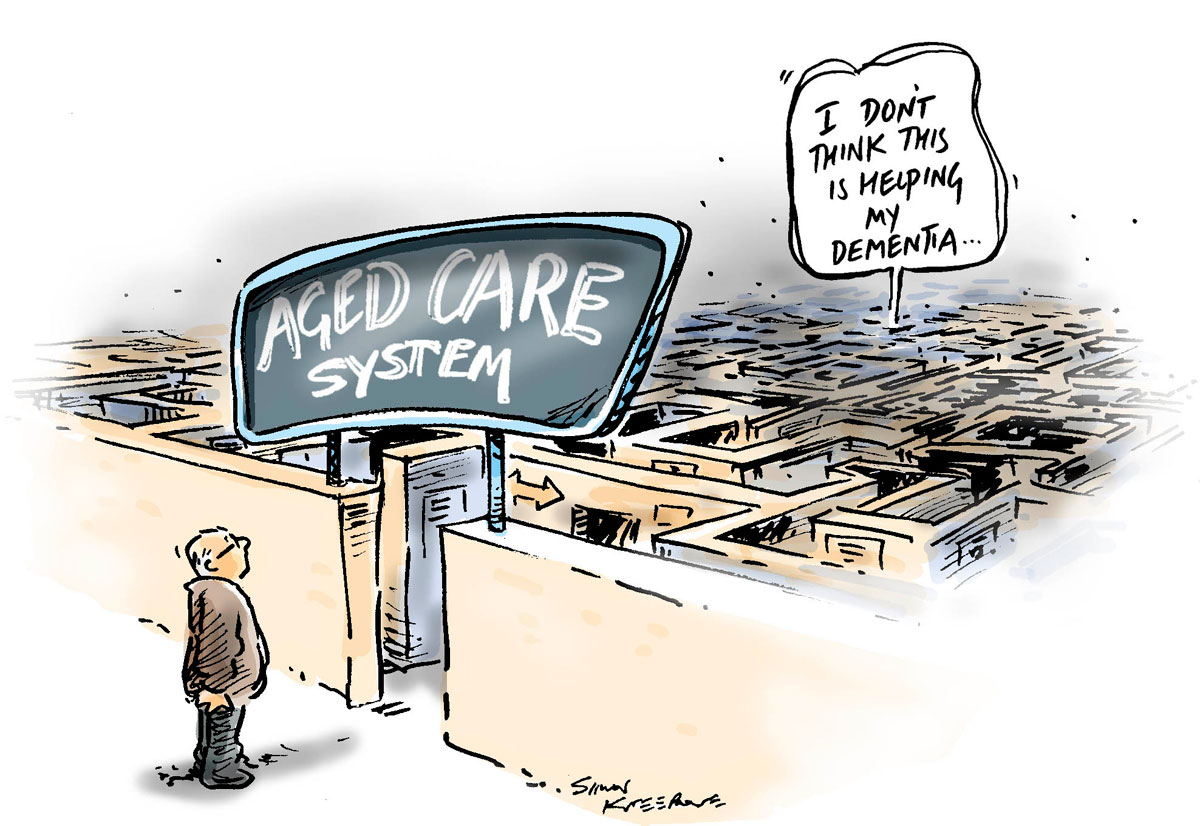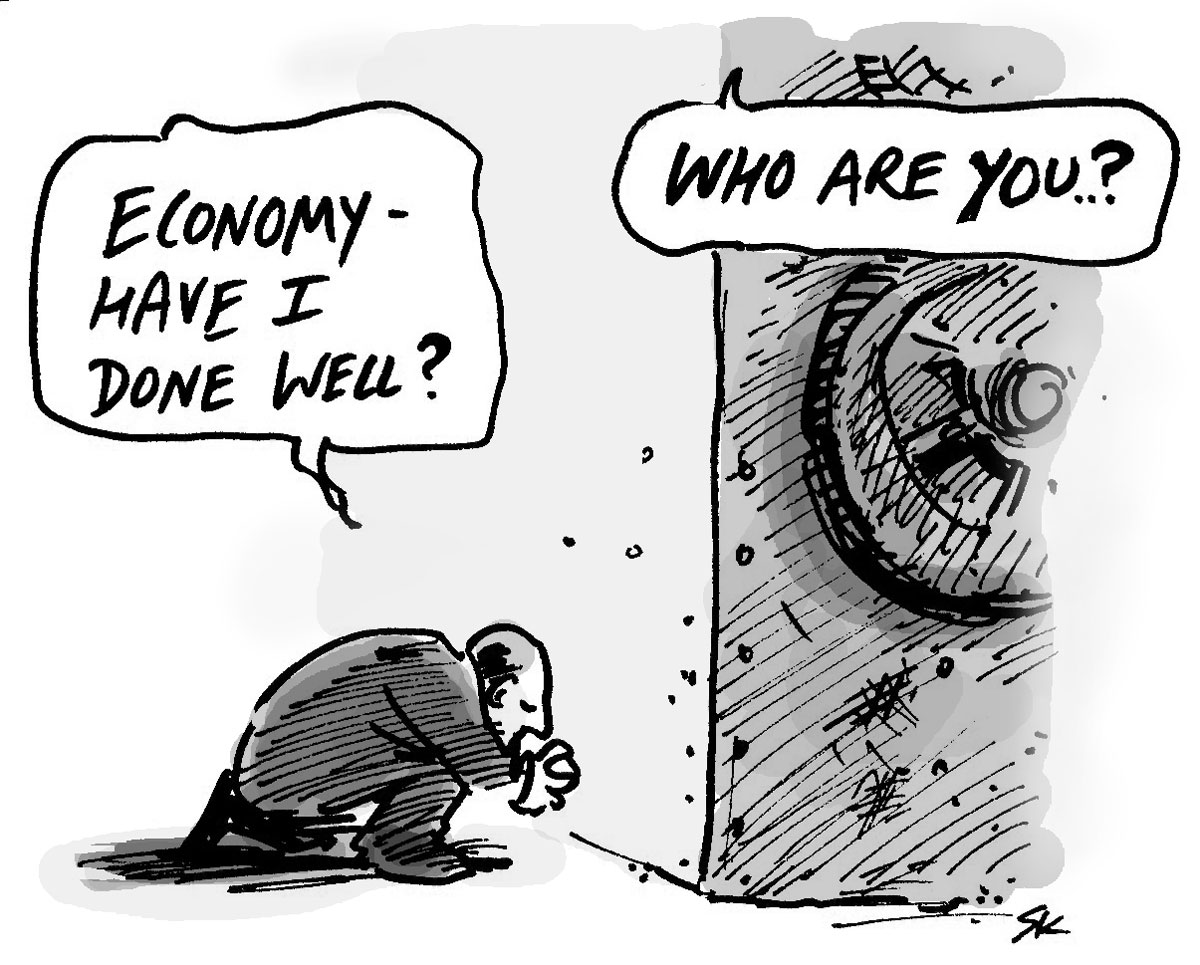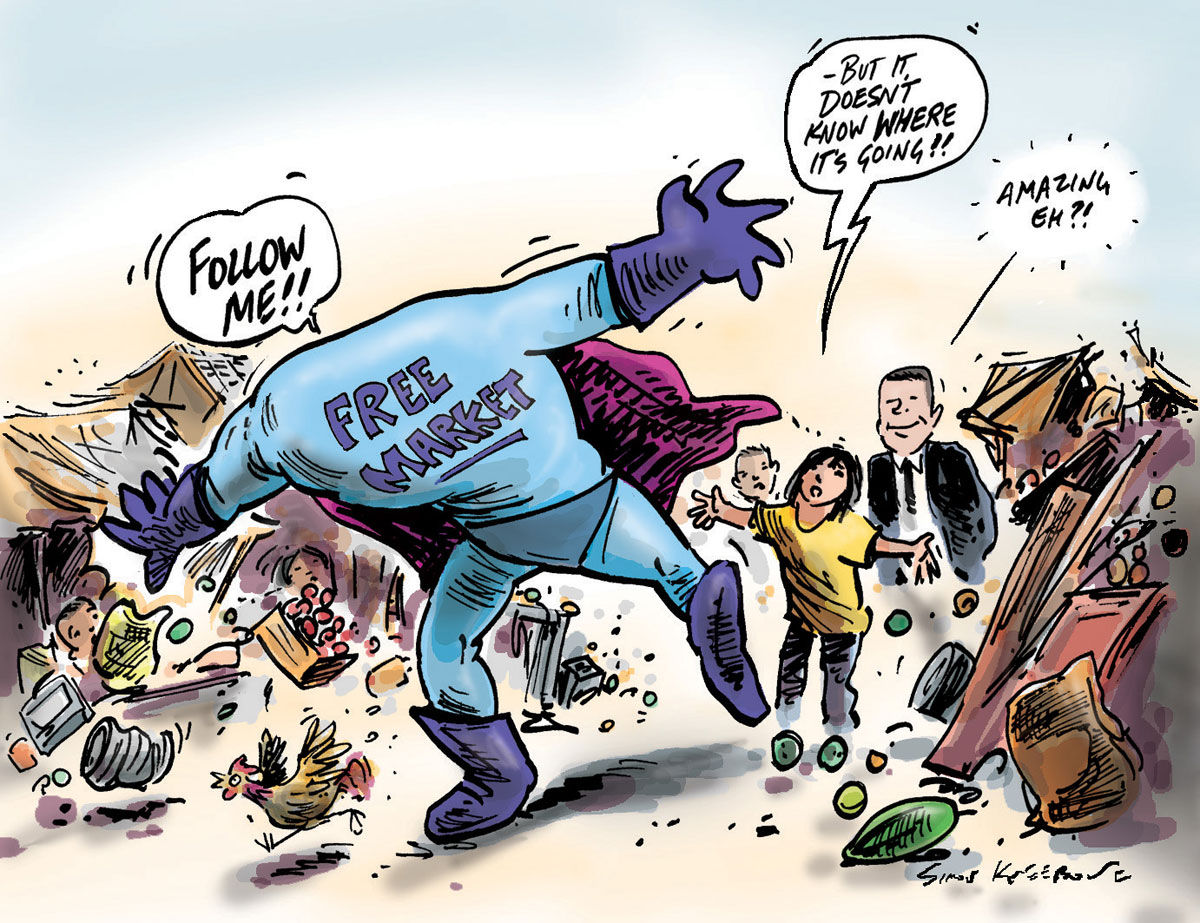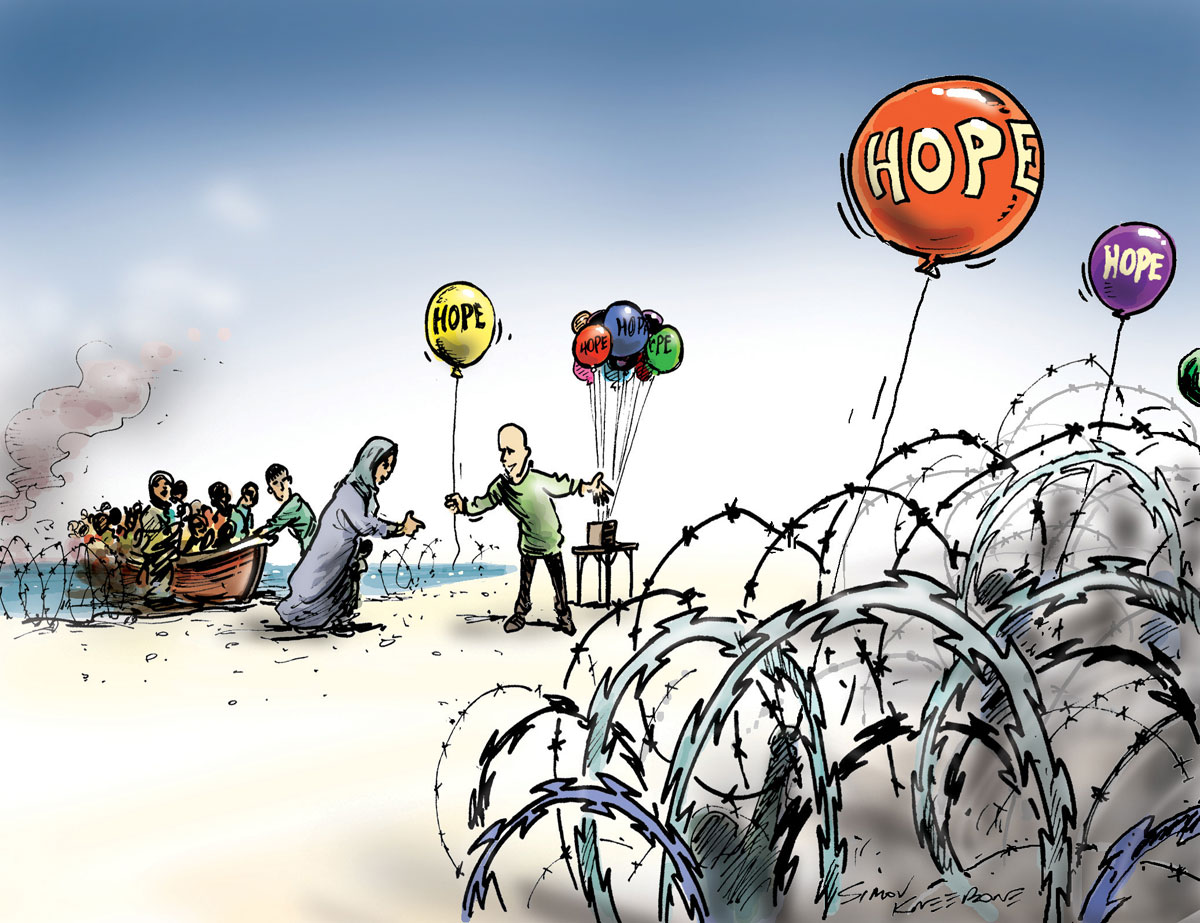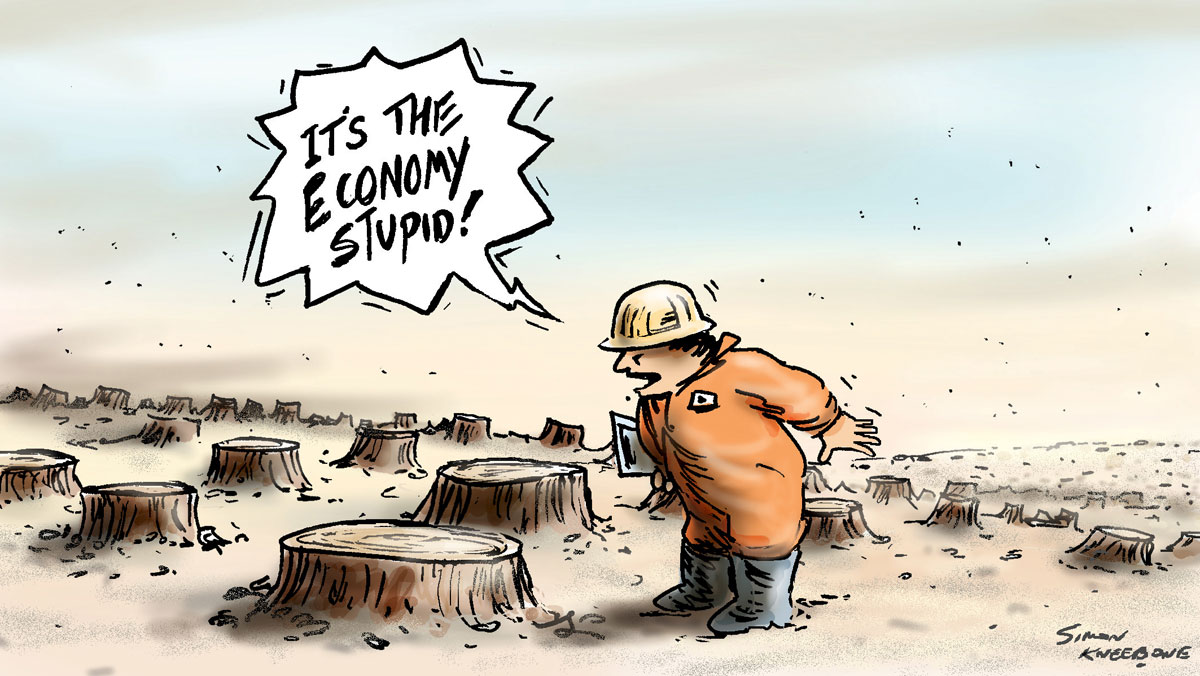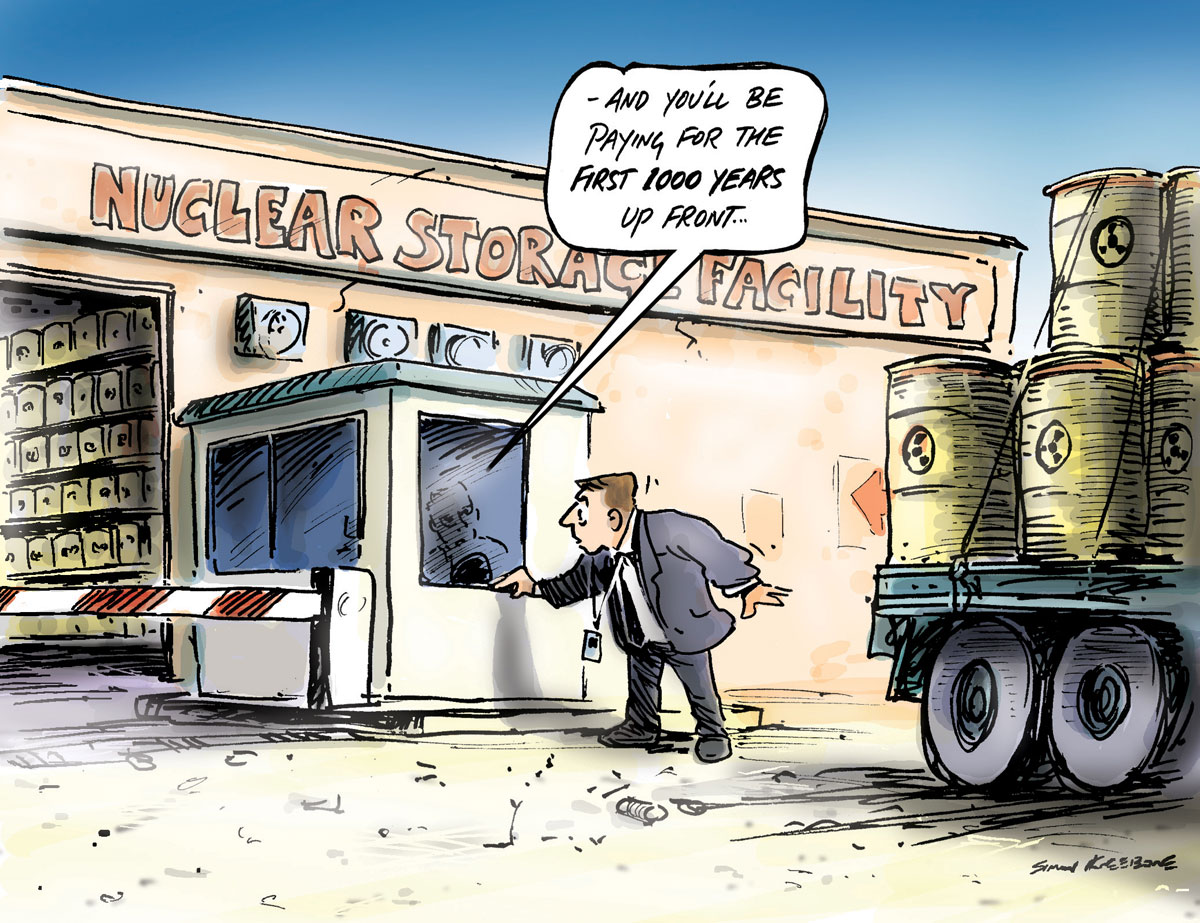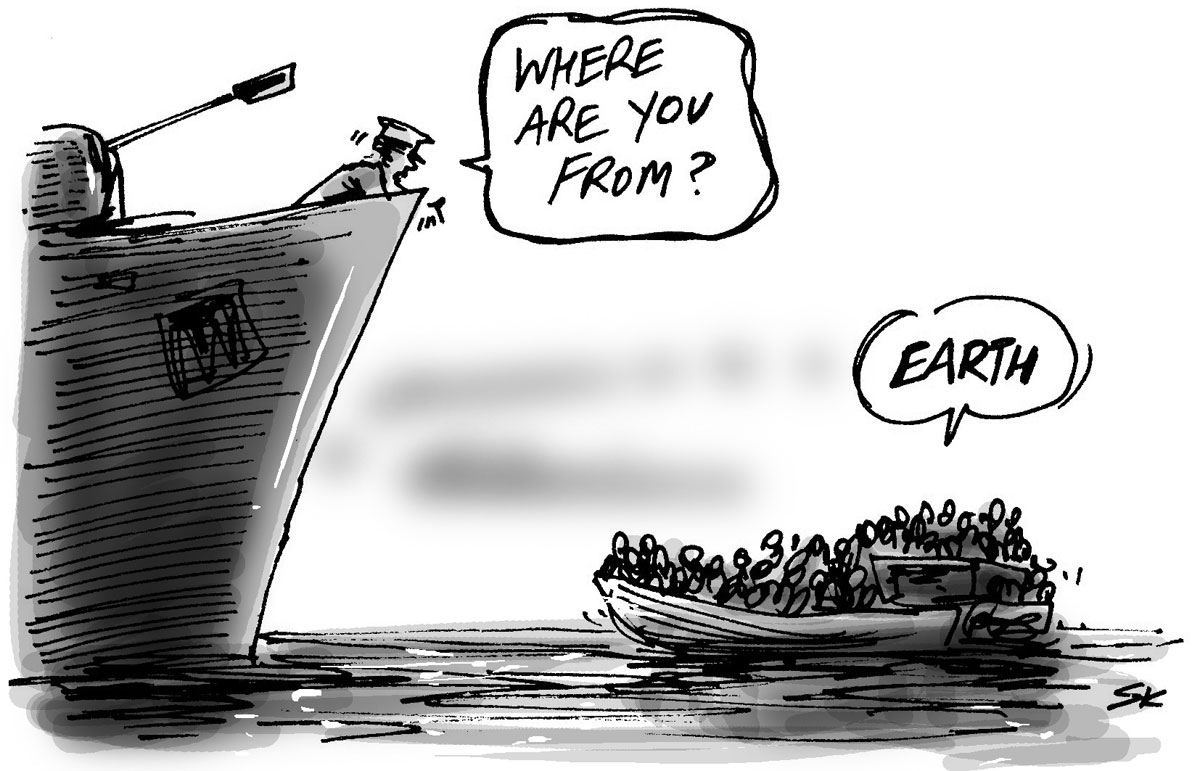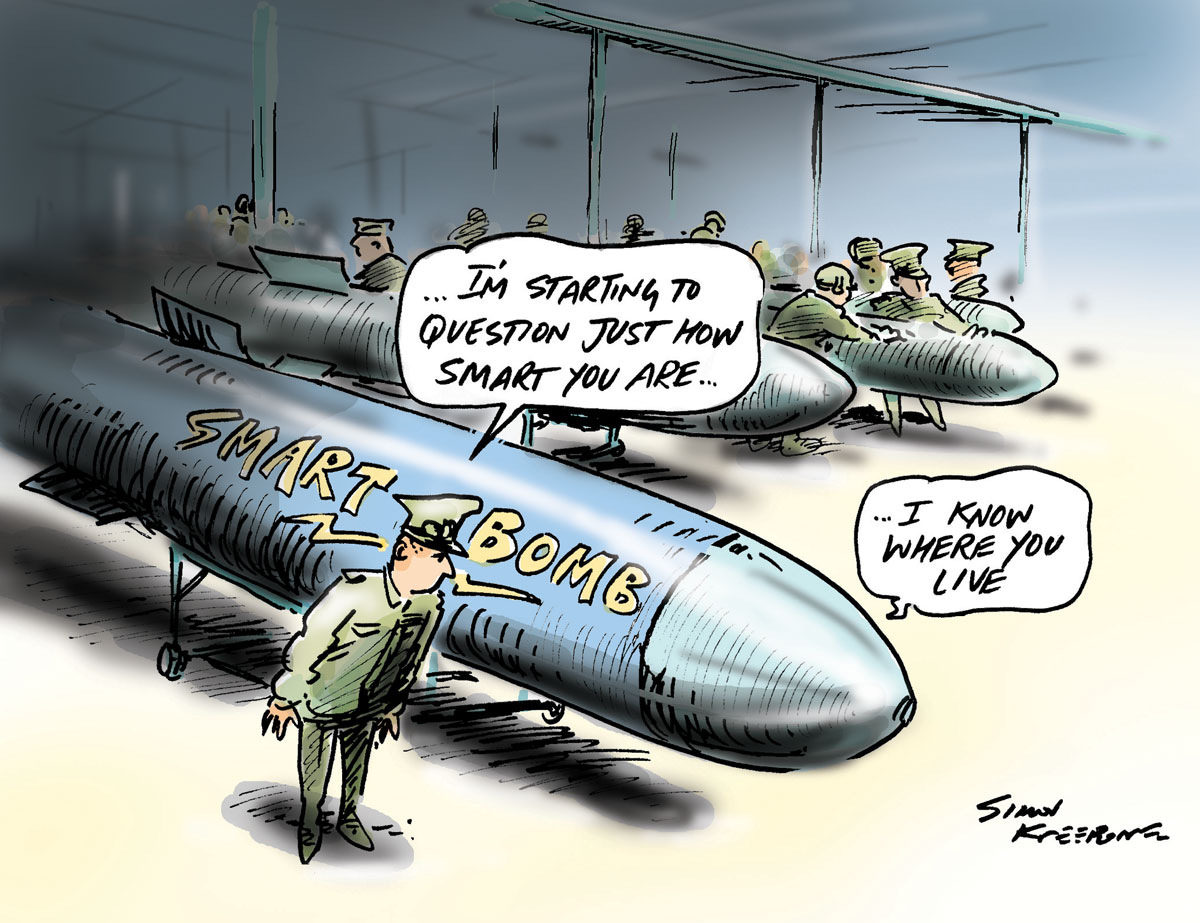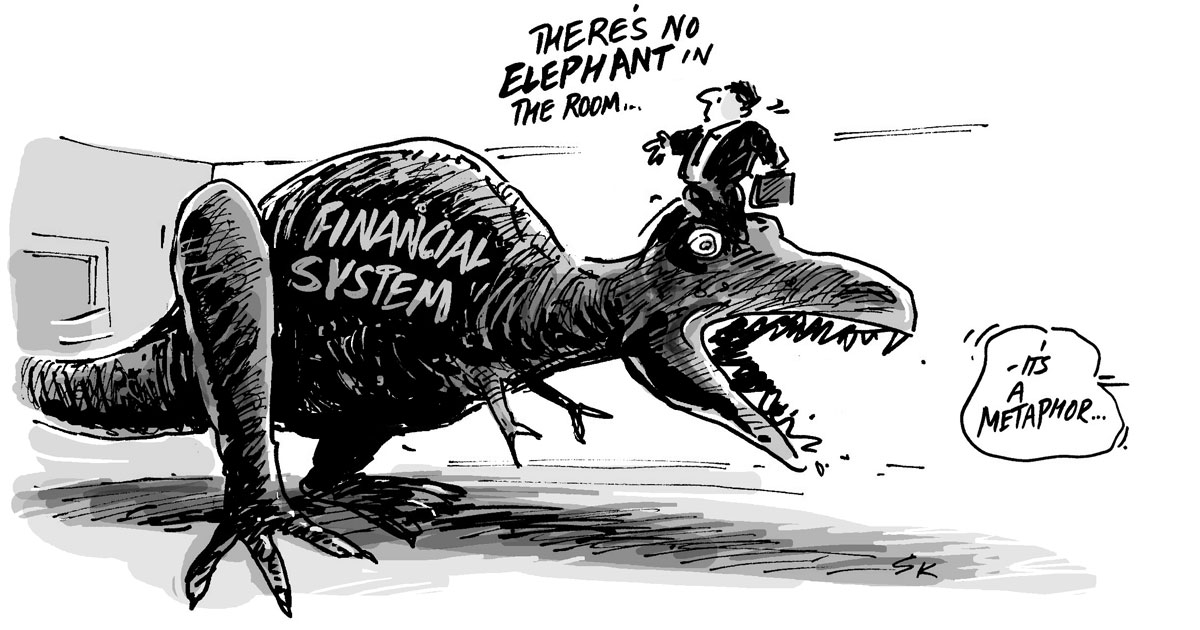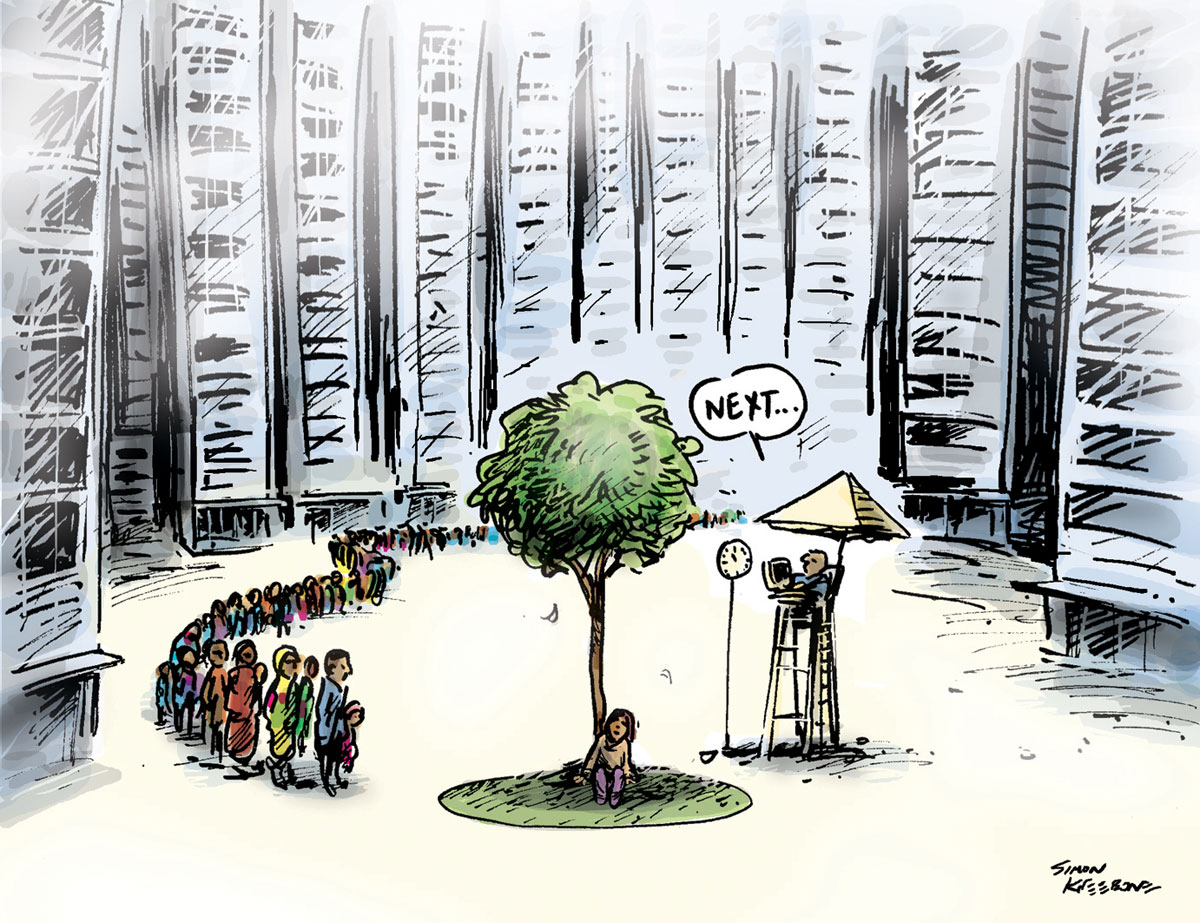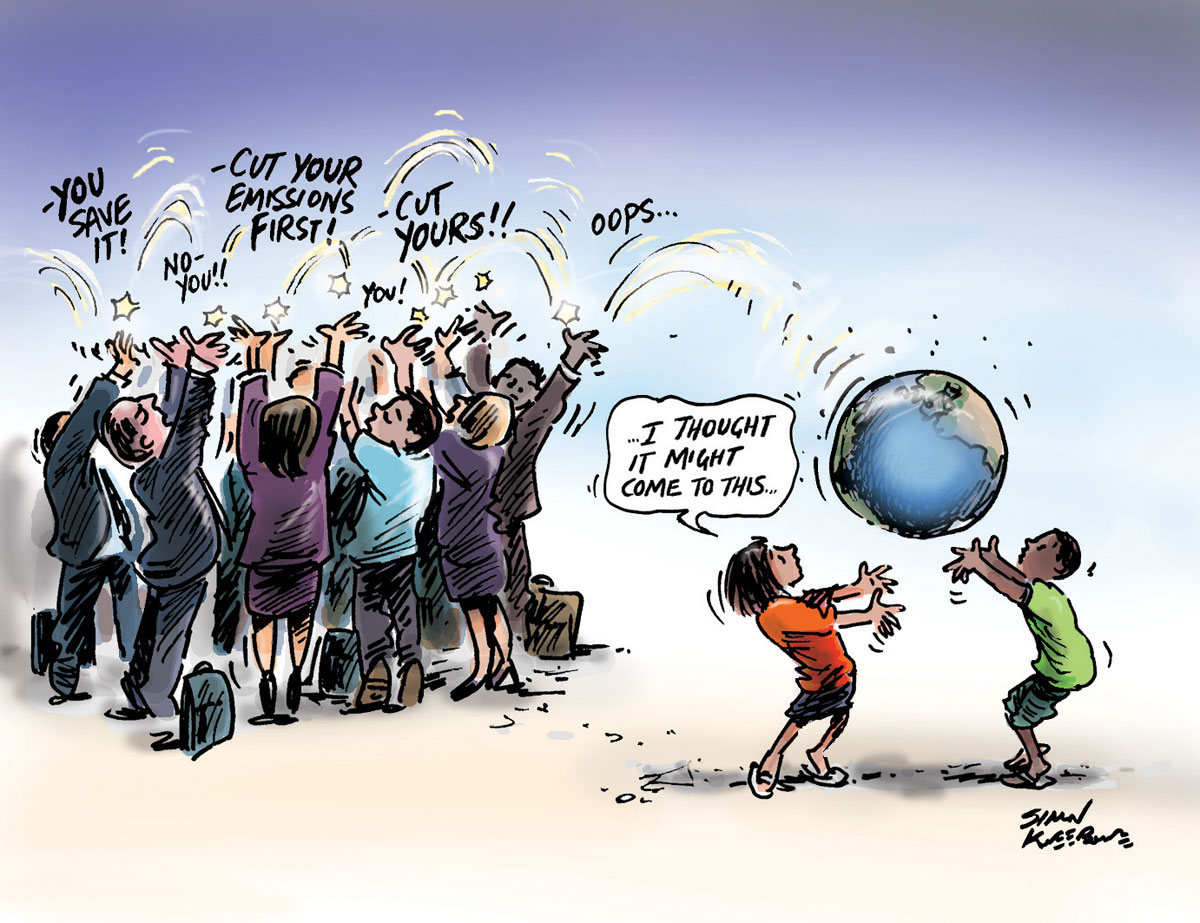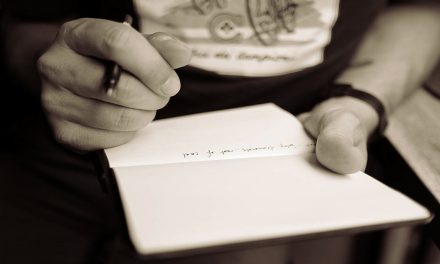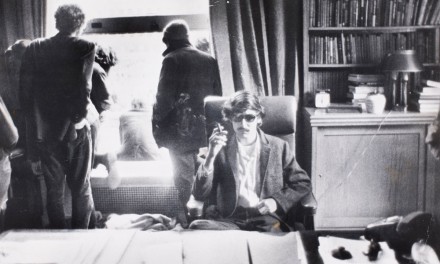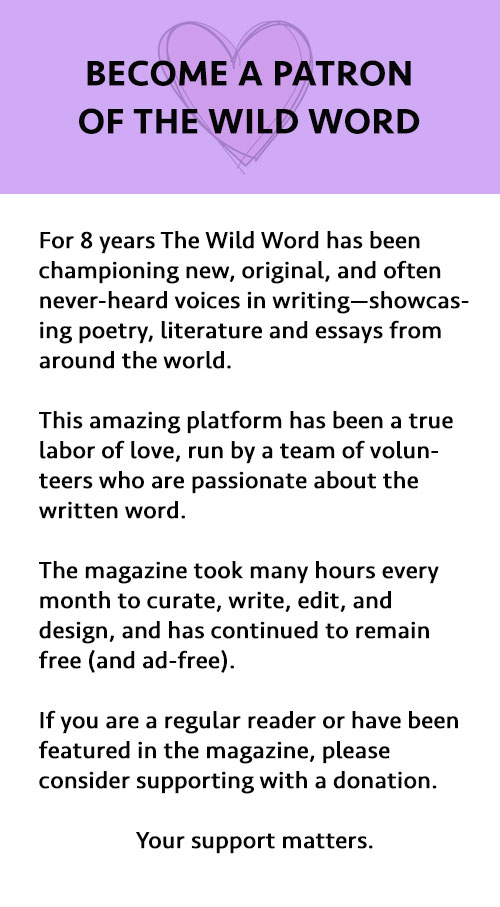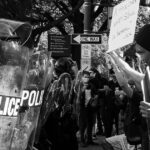CARTOONING IS A STRANGE ACTIVITY
★ ★ ★ ★
THE WORK OF SIMON KNEEBONE
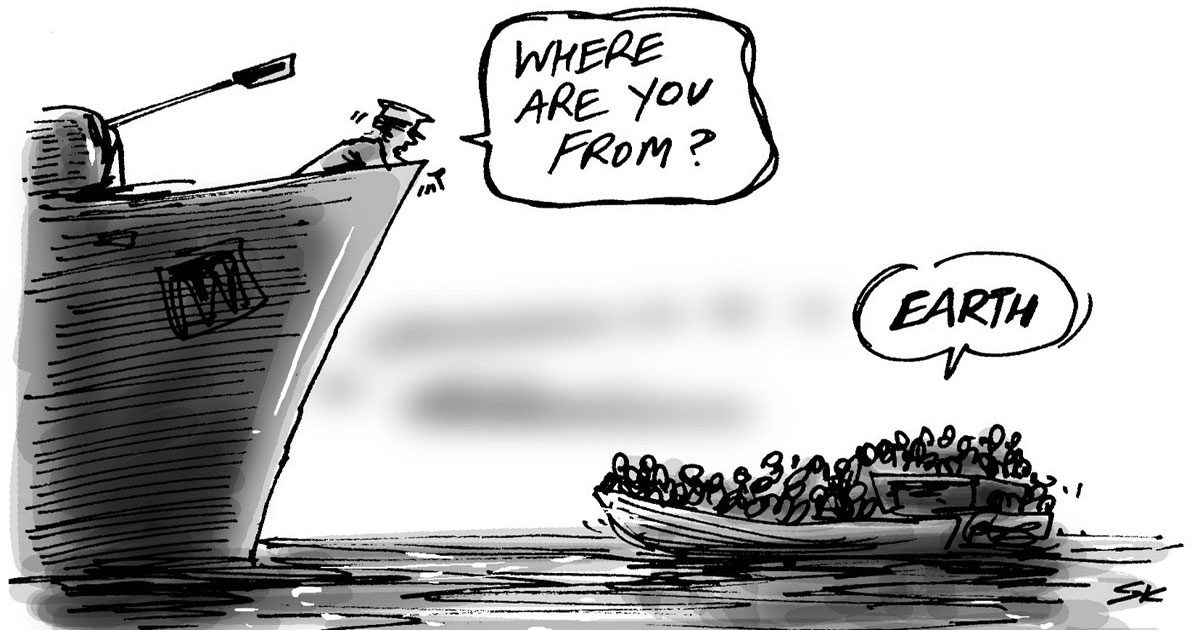
Cartooning is a strange activity. You draw pictures and words about any topic, big or small, that you think is worth some thought. It isn’t always easy, you want to get your facts right, you want to say something that makes sense and also adds to what people are saying about an issue. There’s a lot of scope to play around, not take pontifications seriously, be devil’s advocate, and take something to its logical, but crazy conclusion. It is about having fun, a sense of humour. Fun, even when you are being deadly serious, is a vital element. On top of that, cartooning teases and challenges attitudes. That, to me, is probably its key value.
I have been a freelance cartoonist for over 30 years, so I have had a lot of practice in both the drawing and in getting my head around topics and ideas that often I have only sketchy knowledge of. As a freelancer you do need to be versatile to make an income. The next job could be a series of diagrams for a text book, with cartoony bits and humour to make them more palatable to a student, or it could be an article on the refugee situation needing a strong cartoon to grab the reader and draw them in. Most jobs, as different as they might be, involve the same basic principles: getting ideas and information into some graphic form that communicates with the reader. Humour is the oil that makes those wheels move more easily.
Looking back, my early cartoons were very scratchy and basic but the ideas were there. With cartooning I had stumbled on something that fitted with my way of thinking. I have always tried to understand how other people see things and why they think the way they do. As a teenager I wasn’t particularly politically aware but through my family experience—my mother was a single parent with five children—I developed strong ideas about how people should be treated. These two, sometimes conflicting, aspects of my thinking—seeing things from other points of view, and that people should be treated fairly and with respect—fitted perfectly for me in cartooning. There is a tension between ideals and reality that can be shown in a cartoon, turning the tension into ironic, down-beat humour and placing any resolution in the reader’s hands.
I never intended to become a cartoonist. After studying psychology at university I volunteered and then worked at a community welfare organization in a project supporting unemployed youth. Part of my job was drawing up cartoon and comic pamphlets and handouts explaining rights and services for the unemployed.
The managers at the organization encouraged my cartooning and promoted it through their network. They impressed in me that cartoons can be powerful ways of communicating and that they should have a purpose. It was while working with that organization that my political ideas started to gel. Challenging bits of work came along. In particular a publication for the then upcoming International Year of Disabled Persons. Doing the book’s cartoon illustrations was a crash course in basic human rights, it spelt out clearly just what any person should expect from their society
Around that time I began cartooning at conferences and workshops, using cartoons or illustrations to record key thoughts and ideas as they emerge. This was a different learning experience: working on the spot, the ideas for the cartoons coming from the participants, the things they say, the feeling in the room, the passionate stuff. It is a recording job, at times trying to capture great visions and radical new thinking, but the cartoons should always speak on a personal, people-focused level.
However, most of my cartooning and illustration work has always been done at a desk, at home.
That people focused level that I mentioned is the right place for me to start thinking of a cartoon idea. Many times it helps—with difficult subjects—to try and think how a child would see the issue. That simplified view can often be the key to getting the pieces of a cartoon idea to come together. And simple is important. A cartoon ‘lives’ in a reader’s head for just a few seconds; too complex and the reader moves on. If I start using too many words then I know that I haven’t thought it through enough.
Knowing what you want to have happen in the reader’s head is important too. The perfect cartoon, I’d say, is one where the punch line happens in the reader’s head. You didn’t need to write it in. That is not easy to pull off, of course! Your cartoon does need to give your reader some experience, an emotion, a realization… something that, you hope, will make them pause and think.
One cartoon from long ago is still a favourite and demonstrates what I mean. It was of a father cutting up a fish in front of a child, like a biology lesson, showing the fins, heart, gills—all the bits that made up the fish. At the end the child says “Now put it back together”.
Technology has transformed how I work in wonderful ways. In the early days I simply drew my cartoons in black pen and posted the originals to my clients. If they needed changes or there was a spelling error, they’d post them back. Now the cartoons barely exist. They start as they always did—line drawings—but then they are scanned into the computer, and corrected, coloured, and fiddled with until they are right, then emailed. There are also opportunities to animate them, add sound and more.
And yet, there are powerful cartoons from decades ago, the black and white days. They still hit you and get into your mind. They worked. Computer colour them, animate them and they could just turn into pretty pictures. That is one danger today. It is tempting to make beautiful pictures and almost airbrush out what you wanted to say. I have fallen into that trap at times!
One simple cartoon of mine, an attempt to sum up the refugee crisis did really connect with people. It was a small, scratchy, black and white cartoon. It works so effectively because it of its simplicity: stating the obvious but also being not quite how we usually see these things.
It was drawn to illustrate an article about asylum seekers attempting to get to Australia but it wasn’t until a year or so later, with the refugee crisis in the northern hemisphere, that it took off on social media.
I remember creating it. I drew the situation first. It was like many photos I’d seen in the media: a warship stopping a rickety boat crammed with people. ‘Where are you from?’ I imagined was the usual greeting before turning the boat back—as is the policy here in Australia. Any reader would be familiar with what I had drawn, that was important, all I needed then was a punch-line that really put things in perspective. ‘Earth’ does that so simply.
Traditional political cartooning is in decline. Print media is shrinking and cutting back its budgets. Here where I live in Adelaide a group of a dozen or more cartoonists had been meeting each week for coffee for over 20 years. Originally most had jobs in the print media, others worked for agencies, a couple of us were freelancers. Now there may be only two with print media jobs, and they aren’t secure, and a couple of freelancers. We only need a small table for coffee these days.
I see traditional political cartooning heading towards a crossroads. It is needed more than ever but its outlets are drying up. Its challenge is to evolve, to find new roles, particularly online, and to connect with and inspire a new, younger audience.
Despite all that I have said, the beauty of cartooning will always be getting ideas into some graphic form that, in a few seconds and with a bit of fun, plants an idea in a reader’s head. In the end the cartoons speak for themselves.

Simon Kneebone was born in South Australia in 1954. His family spent two years in the United States in the 1960s and later a year in Hong Kong. He majored in psychology at Adelaide University. After working for two years at the Port Adelaide Central Mission as a youth worker he left to concentrate on cartooning. He has been a freelance cartoonist since 1981 working for a wide range of groups and organisations. His cartoons are published regularly in New Internationalist, Australian Options magazine and on the Pro Bono (Australia) website. His website/blog is simonkneebone.com

